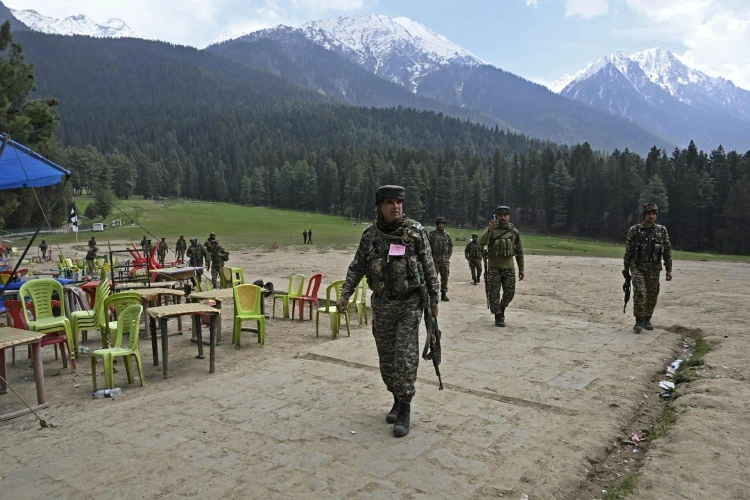Introduction
The Pahalgam terror attack on April 22, 2025, stands as one of the deadliest assaults on civilians in Kashmir in recent memory. With 26 lives lost, mostly tourists from various Indian states and a Nepalese national, the attack not only exposed serious gaps in the region’s security apparatus but also raised alarms over the return of large-scale violence in the Valley. In this blog, we analyze the Pahalgam attack in the context of the “Terror Triangle” — a term now widely used to describe the complex, interconnected threats in Kashmir involving domestic insurgency, cross-border hostility, and the manipulation of global optics.
What Happened During the Pahalgam Terror Attack?
On the afternoon of April 22, 2025, four militants, dressed in camouflage, emerged from a forest near Baisaran meadow — a popular tourist spot 5 km from Pahalgam — and opened fire indiscriminately on unarmed tourists. The gunfire began at around 2:45 PM, catching many by surprise.
Among the 26 victims were tourists from Maharashtra, Gujarat, Karnataka, Odisha, Uttar Pradesh, a Navy officer from Haryana on his honeymoon, and a Nepalese national. The Resistance Front (TRF), an offshoot of the banned Lashkar-e-Taiba (LeT), claimed responsibility. The carnage disrupted the narrative of a peaceful and rejuvenating Kashmir and reintroduced the specter of targeted civilian violence.
The Strategic Context: Kashmir’s “Terror Triangle”
India-Pakistan Tensions and the Ceasefire Breakdown
The attack occurred during a particularly sensitive period in India-Pakistan relations. It followed a deterioration of the 2021 ceasefire recommitment, with Pakistan’s army chief describing Kashmir as the country’s “jugular vein” just a week before the attack. Although Pakistan’s Defence Minister denied involvement, Indian observers viewed the timing with suspicion, especially given the presence of US Vice President JD Vance in India.
Internal Sabotage of Normalcy and Growth
Post-2019, the Indian government has aimed to integrate Kashmir economically and politically, with tourism playing a critical role in the region’s revival. The attackers chose the peak tourist season, targeting Baisaran meadow — a symbol of restored calm — thus attempting to derail economic stability and undermine the post-Article 370 normalcy narrative.
Embarrassment on the Global Stage
The attack coincided with a high-profile international visit, signaling a possible intent to embarrass India diplomatically. Experts argue this synchronization reveals a calculated move to internationalize the Kashmir issue at a time when Delhi’s global stature was prominently in view.
Government and Judicial Response to the Attack
Prime Minister Narendra Modi curtailed his Saudi Arabia visit and returned to India, promising justice and retribution. He declared that the “evil agenda” behind the attack “will never succeed”.
Home Minister Amit Shah reached Srinagar promptly and coordinated high-level security meetings. The Supreme Court of India unanimously condemned the violence, calling it a “diabolical act of mindless violence” and observed two minutes of silence in solidarity.
Kashmir’s Civil Response and Media Protest
Kashmir’s civil society responded with palpable grief. Major newspapers — in both English and Urdu — published blacked-out front pages the next day. The bold headline in Greater Kashmir read, “Gruesome: Kashmir Gutted, Kashmiris Grieving”, with an editorial titled “The massacre in the meadow – Protect Kashmir’s soul.” This symbolic blackout reflected deep public mourning and resistance to the resurgence of terror.
Historical Context: Tourism and Terrorism in Kashmir
The insurgency that began in 1989 has seen periods of intense violence, but attacks specifically targeting tourists had decreased significantly in recent years. Notable exceptions include:
-
2017: An attack on pilgrims killed 8 and injured 19.
-
June 2024: Militants attacked a bus carrying Hindu pilgrims, killing 9 and injuring 33.
The Pahalgam attack, however, marked the deadliest assault on tourists since 2000, rekindling fears about safety in the Valley and threatening the region’s economic rebound.
Strategic Implications for Regional Stability
The calculated nature of the attack — its execution, target, and timing — signals a shift in militant objectives. By directly hitting the tourism sector and drawing international attention, the perpetrators aim to destabilize both the local economy and India’s geopolitical stature.
As security analysts observe, the attack may herald a new phase in insurgency, marked by highly symbolic and civilian-targeted violence. With growing concern about civilian safety and diplomatic ramifications, the region enters a delicate phase of counter-response and international watchfulness.
Frequently Asked Questions (FAQs)
Q1. What is the “Terror Triangle” in Kashmir?
Answer: The “Terror Triangle” refers to the strategic convergence of local insurgents, cross-border actors, and global geopolitical timing, seen in attacks like the one in Pahalgam which aim to destabilize the region and internationalize the Kashmir issue.
Q2. Who claimed responsibility for the Pahalgam attack?
Answer: The Resistance Front (TRF), a shadow outfit of the banned Lashkar-e-Taiba (LeT), claimed responsibility.
Q3. Why was Pahalgam targeted?
Answer: Pahalgam was targeted to hit Kashmir’s peak tourist season and disrupt its economic revival and narrative of normalcy post the abrogation of Article 370.
Q4. What was the Indian government’s immediate reaction?
Answer: Prime Minister Modi returned early from Saudi Arabia and condemned the attack, while Home Minister Amit Shah oversaw high-level security meetings in Srinagar.
Conclusion: Why This Matters for UPSC Aspirants
For UPSC aspirants, the Pahalgam attack exemplifies the intersection of internal security, India’s foreign policy, and terror financing networks. It also highlights how tourism as soft power is increasingly targeted in asymmetric warfare. The incident underlines the fragility of peace in Kashmir and the challenges of counterterrorism in a geopolitically sensitive zone.
Understanding the Pahalgam attack in the context of the “Terror Triangle” offers aspirants a lens to analyze security doctrines, India-Pakistan dynamics, and the evolving nature of terror strategies, all of which are highly relevant for both GS Paper III (Internal Security) and GS Paper II (IR and Governance).




